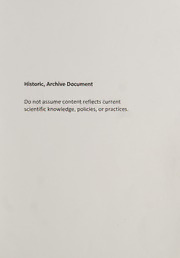Table Of ContentHistoric, Archive Document
Do not assume content reflects current
scientific knowledge, policies, or practices.
The Biologic
and Economic
Assessment
of Propoxur
THE BIOLOGIC AND ECONOMIC
ASSESSMENT OF PROPOXUR
Report of the Propoxur Assessment Team
Submitted to the
U.S. Environmental Protection Agency
March 1992
Edited by
Jack L. Bagent, Assessment Team Chair
Thomas J. Kergel, NAPIAP Technical Writer
Document Prepared by the
National Agricultural Pesticide Impact Assessment Program
Extension Service
U.S. Department of Agriculture
In Cooperation with
Cooperative Extension System,
State Agricultural Experiment Stations,
Other State Agencies, and the
U.S. Environmental Protection Agency
= Mor ® oe eC omit: vat
tyioRiaeB.A & c«boelets oenct, tai(n7e m ‘r imnive
is _ 7
PROPOXUR ASSESSMENT TEAM
Dr. Jack L. Bagent, Chairperson Dr. Armand L. Padula
Room 202L Knapp Hall USDA/ARS
Louisiana State University Building 1070--BARC East
Baton Rouge, Louisiana 70803 Beltsville, Maryland 20705
Dr. Leroy L. Peters Dr. Jerry F. Butler
Box 66 Department of Entomology, McCarty Hall
South Central Research Center University of Florida
Clay Center, Nebraska 68933 Gainesville, Florida 32611
Dr. Walter L. Gojmerac Dr. Craig Osteen
237-C Russell Labs USDA/ERS, Room 424
University of Wisconsin 1301 New York Avenue, NW
Madison, Wisconsin 53706 Washington, DC 20005-4788
Dr. L. (Buck) Waters Dr. Jim Criswell
4509 Oldfield Drive Department of Entomology
Gainesville, Virginia 22065 Oklahoma State University
Stillwater, Oklahoma 74078
Dr. Paul Bergman
6427 Noble Drive Dr. Mike Hammig
McLean, Virginia 22101 Department of Agricultural Economics
Clemson University
Mr. Harold G. Alford Clemson, South Carolina 29631
P.O. Box 3075
El Marcero, California 95618 Dr. David Brassard
US. Environmental Protection Agency,
Dr. Maxcy P. Nolan 401 M Street, SW
Barrow Hall Washington, DC 20460
University of Georgia
Athens, Georgia 30602
Dr. Jack L. Lloyd
Department of Plant Science
University Station
University of Wyoming, WY 82071
ACKNOWLEDGEMENT
We extend sincere appreciation to the assessment team members, State Extension and research
personnel, representatives of the chemical and pest control industries, and members of the U.S.
Department of Agriculture who contributed data for this analysis and gave so generously of their
time in the preparation of this report.
Special gratitude is expressed to Mrs. Sylvia Crochet for typing the document and to Dr. David
Brassard and his staff for developing the tables of the various State recommendations. Appreciation
is expressed to the following people who contributed to this report: Mr. Mike Jones, Mr. Dennis
Vidrine, Dr. Dale K. Pollet, Dr. Gary W. Bennett, Dr. Roger Gold, Dr. Jeff P. LaFage, Dr. James
Bowman, Dr. William F. Lyons, Dr. Philip G. Koehler, Dr. Pat P. Cobb, Dr. Charles S. Apperson, and
Mr. Steve Toth, Jr.
We dedicate this document to Dr. Jeff P. LaFage, in memory of hisR abearels urban entomological
research and education efforts.
National Agricultural Pesticide Impact Assessment Program Staff
Extension Service/NAPIAP, USDA
Washington, DC 20250
Dr. Hollis D. Hall, Program Leader, NAPIAP Administration
Dr. Dennis D. Kopp, National Program Leader
Mr. Thomas J. Kergel, Technical Writer
Ms. Kathryn L. Kimble-Day, Data Analyst
The Cooperative Extension System, a nationwide educational network established through
legislation, is a partnership of the U.S. Department of Agriculture, State land-grant universities, and
county governments.
Mention or display of a trademark, proprietary product, or firm in text or figures does not constitute
an endorsement by the U.S. Department of Agriculture and does not imply approval to the exclusion
of other suitable products or firms.
The Cooperative Extension System’s programs are open to all citizens without regard to race, color,
sex, handicap, religion, age, or national origin.
CONTENTS
Page
Executive Summary
introduction
Description of Chemical
Survey Methods Used in this Assessment
Risk Studies Related to Propoxur
Alternatives to Propoxur
10
Propoxur Usage in Human Dwellings, Industrial 12
and institutional Areas (Except Food
Handling Establishments)
Uses of Propoxur on Military Bases 23
Propoxur Use for Ectoparasite Control on Pets 24
Benefits Analysis for Propoxur Use 31
for Nuisance Out-of-Doors Pests
Benefits Analysis for Propoxur Use in Edible
Product Areas of Food Handling Establishments
Benefits Analysis for Propoxur
Use on Lawns and Turf
References Cited
ace
AC aera
ay : aur Me
We Seeuigiire Th 247 Tee _ Beas Extoneor wed nd od
“nesma at are] Deal Cotte os — a Pert oa p? ;
+ wr te ¢ tqeee repay Jae
: ; a
; . om) Wor ‘poy Chon alipalivinnert, ancl +e
~ inn oi rind (en NRREERIIONG.. Aggeeee
; r . aye, tat Pyare whey
fy,
7 all ft PP ‘ ga
cnetT ~weers i, ait ch oom
quxegers af betabell eotbure iA
Wie 0 ay mircey Ol Jin ytbal enor
UIAVASTs ot pevin rs
' * 0%
laittenel sQevkew® eanmlt nega!
Loot psaxi} excta: wre set
- er ee mayearemr w m
e an SarvietaPir eanwt ytd eg ) ae
if ase re Gonud adeerebiy IOS voto n i 1
| «OS Neen naanenaes So Buoyand a
4 - Lif? ¢ gad " ee Poi Ayi ign are
ornas t ii TORO ee Sa
trvyr L. Kienines-Ohgy, Date Avuiyes ib
"sdiba é4 ged) TUKOQCTS Wt z
ginaiwtmlasteS gniloret Coomt e east’ Sou
LAD e/etive tele ame ny FoI sS GC Coy it »! rei wait ah Jc est | : : a
duis wor, & ok riersiie Twewls yar iheertt. OF Age 1 HENOREa i ie om
rv vor &
L] ae,O T) FGt t#r 4 a! a ‘ ’ a a “ ey,J Orytar [wr <5554, ow 1) text or ae
an erxtoraement by he Vv . Decwteed of Agtoiturd Sre?.ddes Na wey apnea teH s:a
f ove wae MaRS Of Wer “oe =
i 7 : ary
| ine Ceoger wine Exteaman Systdiy's progres ere one Ss © clone withoa req 9 19
r, hondloag, re@gion, dom, or nabotal ongin ce ae
—
ey Wie)

